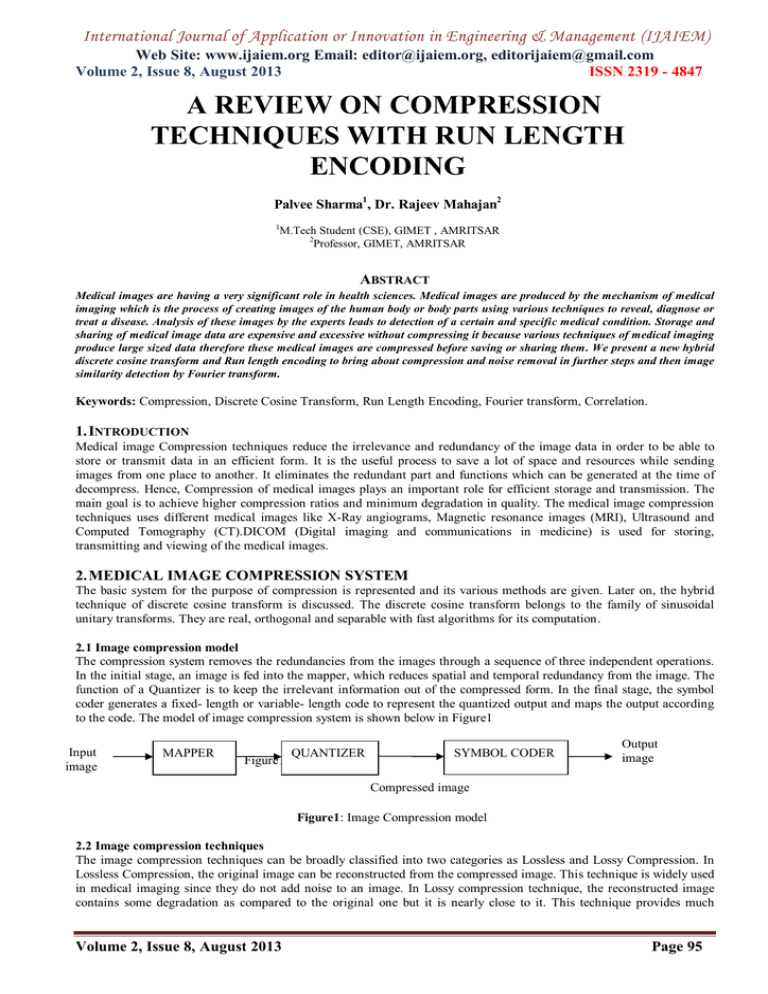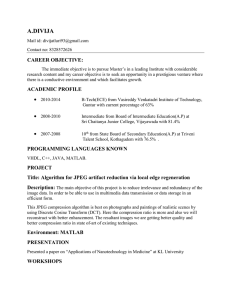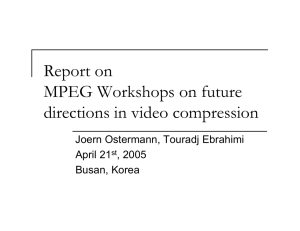A REVIEW ON COMPRESSION TECHNIQUES WITH RUN LENGTH ENCODING
advertisement

International Journal of Application or Innovation in Engineering & Management (IJAIEM) Web Site: www.ijaiem.org Email: editor@ijaiem.org, editorijaiem@gmail.com Volume 2, Issue 8, August 2013 ISSN 2319 - 4847 A REVIEW ON COMPRESSION TECHNIQUES WITH RUN LENGTH ENCODING Palvee Sharma1, Dr. Rajeev Mahajan2 1 M.Tech Student (CSE), GIMET , AMRITSAR 2 Professor, GIMET, AMRITSAR ABSTRACT Medical images are having a very significant role in health sciences. Medical images are produced by the mechanism of medical imaging which is the process of creating images of the human body or body parts using various techniques to reveal, diagnose or treat a disease. Analysis of these images by the experts leads to detection of a certain and specific medical condition. Storage and sharing of medical image data are expensive and excessive without compressing it because various techniques of medical imaging produce large sized data therefore these medical images are compressed before saving or sharing them. We present a new hybrid discrete cosine transform and Run length encoding to bring about compression and noise removal in further steps and then image similarity detection by Fourier transform. Keywords: Compression, Discrete Cosine Transform, Run Length Encoding, Fourier transform, Correlation. 1. INTRODUCTION Medical image Compression techniques reduce the irrelevance and redundancy of the image data in order to be able to store or transmit data in an efficient form. It is the useful process to save a lot of space and resources while sending images from one place to another. It eliminates the redundant part and functions which can be generated at the time of decompress. Hence, Compression of medical images plays an important role for efficient storage and transmission. The main goal is to achieve higher compression ratios and minimum degradation in quality. The medical image compression techniques uses different medical images like X-Ray angiograms, Magnetic resonance images (MRI), Ultrasound and Computed Tomography (CT).DICOM (Digital imaging and communications in medicine) is used for storing, transmitting and viewing of the medical images. 2. MEDICAL IMAGE COMPRESSION SYSTEM The basic system for the purpose of compression is represented and its various methods are given. Later on, the hybrid technique of discrete cosine transform is discussed. The discrete cosine transform belongs to the family of sinusoidal unitary transforms. They are real, orthogonal and separable with fast algorithms for its computation. 2.1 Image compression model The compression system removes the redundancies from the images through a sequence of three independent operations. In the initial stage, an image is fed into the mapper, which reduces spatial and temporal redundancy from the image. The function of a Quantizer is to keep the irrelevant information out of the compressed form. In the final stage, the symbol coder generates a fixed- length or variable- length code to represent the quantized output and maps the output according to the code. The model of image compression system is shown below in Figure1 Input image MAPPER Figure1 QUANTIZER SYMBOL CODER Figure1: Il Output image Compressed image Figure1: Image Compression model 2.2 Image compression techniques The image compression techniques can be broadly classified into two categories as Lossless and Lossy Compression. In Lossless Compression, the original image can be reconstructed from the compressed image. This technique is widely used in medical imaging since they do not add noise to an image. In Lossy compression technique, the reconstructed image contains some degradation as compared to the original one but it is nearly close to it. This technique provides much Volume 2, Issue 8, August 2013 Page 95 International Journal of Application or Innovation in Engineering & Management (IJAIEM) Web Site: www.ijaiem.org Email: editor@ijaiem.org, editorijaiem@gmail.com Volume 2, Issue 8, August 2013 ISSN 2319 - 4847 higher compression ratios than the lossless scheme. Some of the Lossless and Lossy data compression techniques are given below: A. 1. 2. 3. 4. 5. Lossless techniques Run-Length encoding Huffman encoding Arithmetic coding LZW coding Area coding B. 1. 2. 3. Lossy Techniques Transform coding (DCT/DFT) Predictive coding Wavelet coding 2.3 Discrete cosine transform The transform coding comprises an important component of image processing applications. A transform coding involves subdividing an N×N image into smaller non-overlapping n×n sub-images blocks and performing a unitary transform on each block. Transform coding relies on the fact that pixels in an image exhibit a certain level of correlation with their neighboring pixels. These correlations can be exploited to predict the value of a pixel from its respective neighbors. Therefore, transformation maps the spatial (correlated) data into transformed (uncorrelated) coefficients. The most common discrete cosine transform definition of a one dimensional sequence of length N is given by the equation Where α[n] = For n=0 and For n=1, 2…N-1 DCT is a type of Fourier related transform but it operates only on real numbers. The main difference between DCT and DFT is that the former uses only cosine functions while the latter uses both cosines and sines. Also, DCT has better computational efficiency and it imposes periodicity in the time signal without introducing any discontinuity. 2.4 Run length encoding If the bit-stream contains consecutive repeating bit sequences, the bitmask-based compression encodes such patterns using same repeated compressed words, whereas our approach replaces such repetitions using a bitmask of “00”. In this example, the first occurrence will be encoded as usual; whereas the remaining repetitions will be encoded using our method i.e. run length encoding of these sequences may yield a better compression result. Interestingly, to represent such encoding no extra bits are needed. Note that bitmask value 0 is never used, because this value means that it is an exact match and would have encoded using zero bitmasks. Using this as a special marker, these repetitions can be encoded without changing the code format of bitmask-based compression. Input Previous Modified 00XX11X0 010 010 11X010XX 1 11X010XX 1 11X010XX X00X110X 011 011 00XX1110 010 010 X0XXX100 0 0 11 10 0 0 0 11 10 0 X0XXX100 0 0 11 10 0 0 0 01 00 1 X0XXX100 0 0 11 10 0 X0XXX100 0 0 11 10 0 X0XXX100 0 0 11 10 0 X001XX1X 0 0 01 10 0 0 0 01 10 0 Figure 2: Run Length Encoding For compression The above figure shows Efficiency for compression and decompression. When we are given 10 vectors and each vector length 8 bits so totally you are given 80 bit input data. Using previous method we can reduce only 20 bits i.e 60 bits are there. Volume 2, Issue 8, August 2013 Page 96 International Journal of Application or Innovation in Engineering & Management (IJAIEM) Web Site: www.ijaiem.org Email: editor@ijaiem.org, editorijaiem@gmail.com Volume 2, Issue 8, August 2013 ISSN 2319 - 4847 3. PROPOSED ALGORITHM The compression algorithm for medical images is based on the discrete cosine transform and it comprises of the following steps: 1. Acquisition of images from medical databases. 2. Convert the colored image into grey level image. 3. Preprocessing of medical images by discrete cosine transform based compression which will eliminate undesired signals, symbols that arise with acquisition process. 4. Further, Run length encoding will be performed for eliminating any unwanted noise and pending redundancy of sequence and symbols. 5. Images will be processed through Fourier transform to find the amplitude difference with correlation method and will identify the similarity between two images. 6. Finally, the comparison of the images will be done to find the best similarity result with compression. 4. CONCLUSION AND FUTURE WORK The paper shows that using Fourier transform and Discrete Wavelet transform, the software is developed under MatLab mathematical platform that allows the efficient compression of the medical images. The quality of the image after compression is the main criteria that all the compression techniques should hold. The proposed compression scheme may have superior performance in a medical image. References [1] V.K. Bairagi1 A.M. Sapkal,‘‘Automated region-based hybrid compression for digital imaging and communications in medicine magnetic resonance imaging images for telemedicine applications’’, The Institution of Engineering and Technology, IEEE, 2012 [2] M Alpetekin Engin and Bulent Cavusoglu, IEEE communication letter, vol 15, no-11, November 2011, pg 12341237. [3] Digital Image Processing using Matlab by Rafael C. Gonzalez & Richard E. Woods. [4] Ruchika, Mooninder, Anant Raj Singh,” Compression of Medical images using Wavelet Transforms”, International Journal of Soft Computing and Engineering (IJSCE) ISSN: 2231-2307, Volume -2, Issue-2, May-2012. [5] Vaishali G. Dubey and Jaspal Singh, “3D Medical Image Compression Using Huffman Encoding Technique” International Journal of Scientific and Research Publications, Volume 2, Issue 9, September 2012, ISSN 2250-3153. [6] Syed Ali Khayam, “DCT-Theory and Applications”, March 2003. [7] D.A Huffman, “A method for the construction of Minimum redundancy Codes”, Proc. IRE, vol.40, no.10, p.p. 10981101,1952. [8] Jagadish H.Pujar, Lohit M. Kadlaskar, “ A new Looseless method of image compression and decompression usingHuffman coding techniques”, Journal of Theoretical and Applied Information Technology, JATIT. [9] S.Jagadeesh, T.Venkateswarlu, Dr.M.Ashok,” Run length encoding and bit mask based Data Compression and Decompression Using Verilog”, International Journal of Engineering Research & Technology, Vol.1, Issue.7, September, 2012. [10] S.Grace Chang, Bin Yu, and Martin Vetterli,”Adaptive Wavelet Thresholding for Image Denoisingand Compression”, IEEE Transactions on Image Processing, Vol. 9, No. 9, September 2000. Volume 2, Issue 8, August 2013 Page 97





